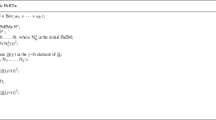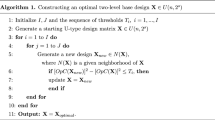Abstract
In real-life projects, in order to obtain precious information about the process, we often partition the experiment into two stages with equal size. The main purpose of this article is to study how to choose the first stage experimental designs (FSED) and the second stage experimental designs (SSED) to construct uniform or at least good approximation to uniform (GATU) two-stage experimental designs (TSED) that involve a mixture of \(\omega _1\ge 1\) factors with \(\mu _1\ge 2\) levels and \(\omega _2\ge 1\) factors with \(\mu _2\ge 2\) levels whether regular or nonregular. Through theoretical justification, this paper proves that the SSED is uniform (GATU) if and only if the FSED is uniform (GATU), the TSED is uniform (GATU) if and only if its corresponding complementary TSED is uniform (GATU), and the TSED is uniform or at least GATU if and only if the FSED is uniform.
Similar content being viewed by others
References
Althöfer I, Koschnick K-V (1991) On the convergence of “Threshold Accepting”. Appl Math Optim 24:183–195
Bates JR, Buck R, Riccomagno E, Wynn HP (1996) Experimental design and observation for large eystems. J R Stat Soc B 57:77–94
Box GEP, Hunter WG, Hunter JS (1978) Statistics for experiments. Wiley, NewYork
Bullington KE, Hool JN, Maghsoodloo S (1990) A simple method for obtaining resolution IV designs for use with Taguchis orthogonal arrays. J Qual Technol 22(4):260–264
Cheong KTW, Htay K, Tan RHC, Lim M (2012) Identifying combinatorial growth inhibitory effects of various plant extracts on leukemia cells through systematic experimental design. Am J Plant Sci 3:1390–1398
Elsawah AM (2016) Constructing optimal asymmetric combined designs via Lee discrepancy. Stat Probab Lett 118:24–31
Elsawah AM (2017a) A closer look at de-aliasing effects using an efficient foldover technique. Statistics 51(3):532–557
Elsawah AM (2017b) A powerful and efficient algorithm for breaking the links between aliased effects in asymmetric designs. Aust N Z J Stat 59(1):17–41
Elsawah AM (2017c) Constructing optimal router bit life sequential experimental designs: new results with a case study. Commun Stat Simul Comput. https://doi.org/10.1080/03610918.2017.1397164
Elsawah AM, Qin H (2016) An efficient methodology for constructing optimal foldover designs in terms of mixture discrepancy. J Korean Stat Soc 45:77–88
Elsawah AM, Qin H (2017a) A new look on optimal foldover plans in terms of uniformity criteria. Commun Stat Theory Methods 46(4):1621–1635
Elsawah AM, Qin H (2017b) Optimum mechanism for breaking the confounding effects of mixed-level designs. Comput Stat 32(2):781–802
Fang KT (1980) The uniform design: application of number-theoretic methods in experimental design. Acta Math Appl Sin 3:363–372
Fang KT, Lin DKJ, Qin H (2003) A note on optimal foldover design. Stat Probab Lett 62:245–250
Fang KT, Tang Y, Yin J (2005) Lower bounds for the wrap-around \(L_2\)- discrepancy of symmetrical uniform designs. J Complex 21:757–771
Fang KT, Ke X, Elsawah AM (2017) Construction of uniform designs via an adjusted threshold accepting algorithm. J Complex 43:28–37
Hickernell FJ (1998) A generalized discrepancy and quadrature error bound. Math Comput 67:299–322
Li W, Lin DKJ (2003) Optimal foldover plans for two-level fractional factorial designs. Technometrics 45:142–149
Li W, Lin DKJ, Ye KQ (2003) Optimal foldover plans for non-regular orthogonal designs. Technometrics 45:347–351
Li PF, Liu MQ, Zhang RC (2005) Choice of optimal initial designs in sequential experiments. Metrika 61(2):127–135
Montgomery DC, Runger GC (1996) Foldover of \(2^{k-p}\) resolution IV experimental designs. Qual Technol 28:446–450
Ou Z, Qin H (2017) Optimal foldover plans of asymmetric factorials with minimum wrap-around \(L_2\)-discrepancy. Pap Stat. https://doi.org/10.1007/s00362-017-0892-x
Wang Y, Fang KT (1981) A note on uniform distribution and experimental design. Chin Sci Bull 26:485–489
Wang B, Robert GM, John FB (2010) A note on the selection of optimal foldover plans for 16- and 32-run fractional factorial designs. J Stat Plan Inference 140:1497–1500
Zhou YD, Ning JH (2008) Lower bounds of the wrap-around \(L_2\)-discrepancy and relationships between MLHD and uniform design with a large size. J Stat Plan Inference 138:2330–2339
Zhou YD, Ning JH, Song XB (2008) Lee discrepancy and its applications in experimental designs. Stat Probab Lett 78:1933–1942
Acknowledgements
The author greatly appreciate helpful suggestions of the two referees that significantly improved the paper. The author also thank Prof. Kai-Tai Fang for his guidance and support. This work was partially supported by the UIC Grants (Nos. R201409 and R201712) and the Zhuhai Premier Discipline Grant.
Author information
Authors and Affiliations
Corresponding author
Rights and permissions
About this article
Cite this article
Elsawah, A.M. Choice of optimal second stage designs in two-stage experiments. Comput Stat 33, 933–965 (2018). https://doi.org/10.1007/s00180-017-0778-3
Received:
Accepted:
Published:
Issue Date:
DOI: https://doi.org/10.1007/s00180-017-0778-3




